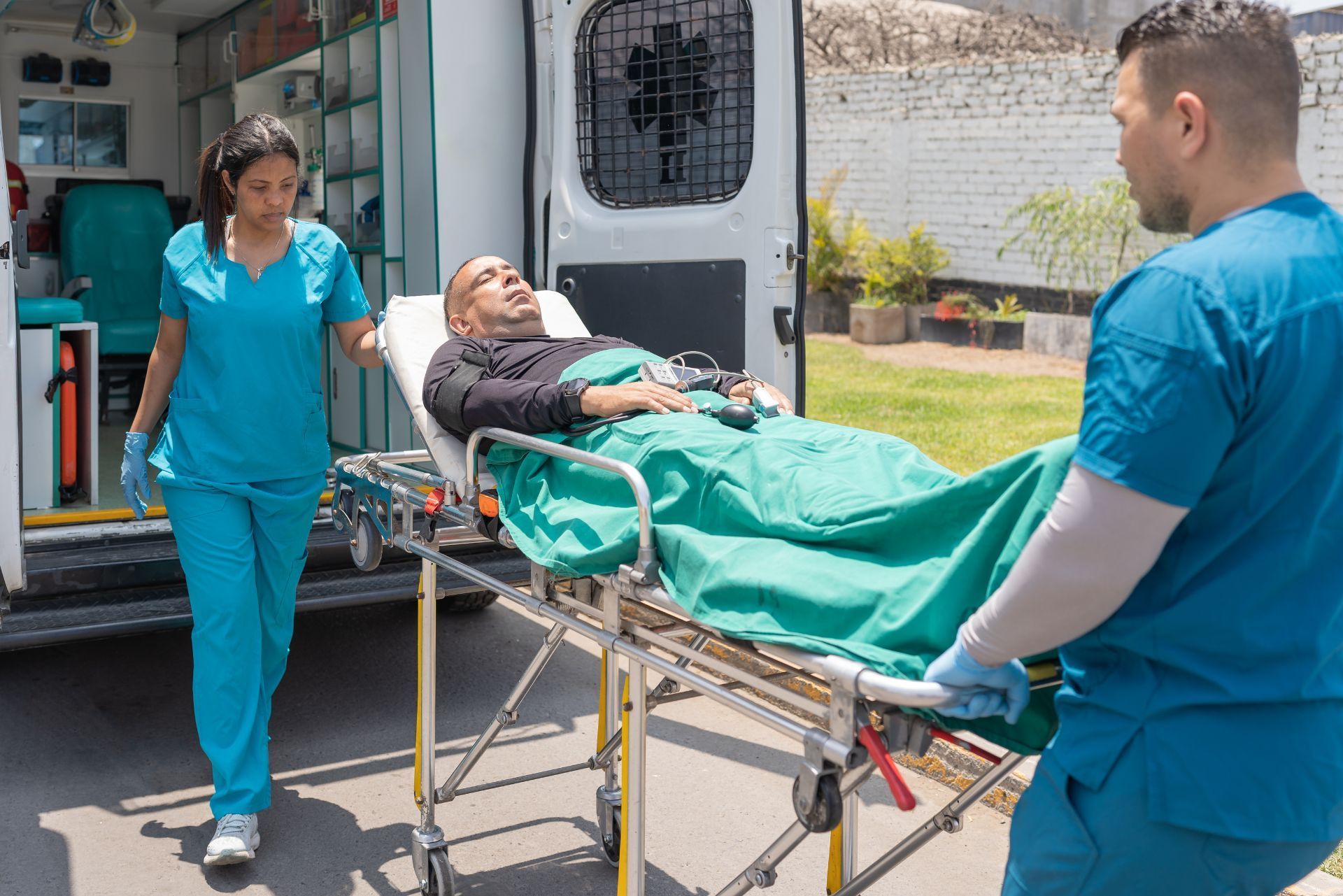Top 3 Recommended Policies

Medical transport insurance is a crucial aspect of healthcare logistics, especially in a state like New Mexico where vast landscapes and rural areas can complicate access to medical facilities. Understanding the nuances of this insurance can help individuals and healthcare providers navigate the complexities of medical transportation. This article delves into the essentials of medical transport insurance in New Mexico, covering its importance, types, coverage options, and how to choose the right plan.
Understanding Medical Transport Insurance
Medical transport insurance provides coverage for the costs associated with transporting patients to and from medical facilities. This can include ground ambulance services, air ambulance services, and non-emergency medical transportation. In New Mexico, where distances can be significant, having the right insurance can make a substantial difference in patient care and financial burden.
Why Is Medical Transport Insurance Important?
The importance of medical transport insurance cannot be overstated. In emergencies, timely transportation can be the difference between life and death. Medical transport insurance ensures that patients receive the necessary care without the added stress of financial burdens. It covers various scenarios, from routine medical appointments to critical emergency situations.
Moreover, with New Mexico's diverse geography, many residents may require specialized transport services. Insurance can alleviate the costs associated with these services, making healthcare more accessible to everyone, regardless of their location. This is particularly vital in rural areas where medical facilities may be far away, and the need for reliable transport becomes essential for maintaining health and well-being.
Types of Medical Transport Services
In New Mexico, medical transport services can be broadly categorized into three types: emergency medical transport, non-emergency medical transport, and air ambulance services. Each type serves a distinct purpose and comes with its own set of insurance considerations.
- Emergency Medical Transport: This includes ambulance services that respond to emergencies. Coverage typically includes both basic life support (BLS) and advanced life support (ALS) services. These services are equipped with trained medical personnel who can provide immediate care during transit, ensuring that patients receive critical interventions while en route to a hospital.
- Non-Emergency Medical Transport: This service is designed for patients who need transportation to medical appointments but do not require immediate medical attention. It often includes wheelchair vans and sedans. Non-emergency transport is particularly beneficial for individuals with chronic conditions who need regular treatments, such as dialysis or physical therapy, allowing them to maintain their treatment schedules without the added worry of how to get there.
- Air Ambulance Services: These services are crucial for transporting patients over long distances or to specialized facilities. Insurance coverage can vary significantly due to the high costs associated with air transport. Air ambulances are equipped with advanced medical equipment and staffed by highly trained personnel, making them an essential resource for critical care when time is of the essence.
Additionally, understanding the nuances of each type of transport service can empower patients and their families to make informed decisions about their healthcare needs. For instance, knowing when to opt for emergency transport versus scheduling a non-emergency ride can not only save time but also reduce unnecessary costs. Furthermore, many insurance policies offer additional benefits, such as coverage for mileage or accommodation for family members accompanying the patient, which can further ease the logistical challenges associated with medical transport.

When selecting medical transport insurance, it's essential to understand the various coverage options available. Each plan can differ significantly in terms of what it covers, so evaluating these options carefully is vital.
Basic Coverage
Basic coverage typically includes essential services such as ground ambulance transport. This is often the minimum requirement for most insurance plans. However, it may not cover all associated costs, such as mileage or additional fees for advanced life support services. Moreover, basic coverage often has limitations on the distance of transport, which can be a crucial factor in emergencies where time is of the essence. Understanding these limitations can help individuals make informed decisions about their healthcare needs.
Comprehensive Coverage
Comprehensive coverage is more extensive and includes a wider range of services. This may cover emergency and non-emergency transport, air ambulance services, and even transportation for specialized medical treatments. While this type of coverage can be more expensive, it provides peace of mind for patients and their families. Additionally, comprehensive plans often include benefits such as coverage for international travel, which is particularly advantageous for those who may need medical attention while abroad. This added layer of security can alleviate concerns about unexpected medical emergencies during travel.
Supplemental Insurance
Supplemental insurance can be purchased in addition to
primary health insurance. This type of policy can help cover out-of-pocket costs associated with medical transport that may not be included in the primary plan. It can be particularly beneficial for those who frequently require medical transport services. For instance, individuals with chronic health conditions or those undergoing regular treatments may find that supplemental insurance significantly reduces their financial burden. Furthermore, some supplemental plans offer additional perks, such as coverage for transportation to routine medical appointments, which can enhance overall accessibility to healthcare services.
Factors Influencing Medical Transport Insurance Costs
The cost of medical transport insurance can vary widely based on several factors. Understanding these factors can help individuals make informed decisions when selecting a plan.
Geographic Location
In New Mexico, geographic location plays a significant role in determining insurance costs. Rural areas may have higher transport costs due to the distance to medical facilities, while urban areas may have more competitive pricing due to the availability of multiple service providers. Additionally, the local healthcare infrastructure can impact costs; regions with fewer hospitals or specialized care facilities may see higher transport rates, as patients must be transported over longer distances to receive adequate care. This can lead to increased premiums for residents in these areas, making it essential for them to carefully evaluate their insurance options.
Type of Transport Required
The type of transport needed can also influence insurance premiums. Emergency services, particularly air ambulances, tend to be more expensive due to the specialized equipment and personnel involved. Non-emergency transport options usually have lower premiums. However, the choice between ground and air transport can also depend on the urgency of the medical situation. For instance, if a patient requires immediate care that cannot be provided locally, air transport may be the only viable option, significantly raising costs. Furthermore, insurance plans may vary in coverage for different types of transport, so it’s crucial for individuals to thoroughly review their policy details to understand what is included.
Patient's Medical Condition
A patient's medical condition can affect insurance costs as well. Individuals with chronic illnesses or those requiring frequent medical transport may face higher premiums compared to those who only need occasional transport. Moreover, the complexity of a patient's condition can necessitate specialized transport services, which can further elevate costs. For example, patients needing transport with advanced medical equipment, such as ventilators or IV drips, may incur additional charges that are not typically covered under standard plans. This highlights the importance of assessing one’s health needs and potential transport requirements when selecting an insurance policy, as these factors can significantly impact overall expenses.
Choosing the Right Medical Transport Insurance Plan
Selecting the right medical transport insurance plan is crucial for ensuring adequate coverage. Here are some key considerations to keep in mind when evaluating options.
Assessing Coverage Needs
Before choosing a plan, it is essential to assess individual or family needs. Consider how often medical transport services are used and the types of services required. For families with elderly members or individuals with chronic conditions, comprehensive coverage may be necessary. Additionally, think about the geographical areas where services might be needed. Some plans may offer nationwide coverage while others are limited to specific regions, which can significantly impact accessibility during emergencies.
Moreover, consider the types of transport services that may be needed. For instance, some plans might cover only basic ambulance services, while others may include air transport or non-emergency medical transportation. Understanding these nuances can help ensure that the chosen plan aligns with potential future needs, especially in cases where specialized transport might be required for complex medical conditions.
Comparing Providers
Researching and comparing different insurance providers can lead to better choices. Look for companies that specialize in medical transport insurance and read customer reviews to gauge their reputation and reliability. It's also beneficial to check if the provider has partnerships with local transport services. These partnerships can enhance service quality and response times, which is particularly important in urgent situations where every minute counts.
Additionally, consider the financial stability of the insurance provider. A company with a strong financial background is more likely to fulfill claims promptly and efficiently. Tools such as ratings from independent agencies can provide insight into the provider’s reliability and customer service record, helping you make a more informed decision.
Understanding Policy Terms
Carefully review the terms and conditions of each policy. Pay attention to exclusions, limitations, and the claims process. Understanding these details can prevent surprises when it comes time to use the insurance. It is also wise to inquire about any waiting periods that may apply before coverage begins, as this can affect your access to services during critical times.
Furthermore, consider the flexibility of the policy in terms of upgrades or changes. Life circumstances can change rapidly, and having the option to adjust your coverage can be invaluable. Some plans may allow for additional riders or enhancements to be added, which can provide peace of mind as health needs evolve over time.

Common Misconceptions About Medical Transport Insurance
There are several misconceptions surrounding medical transport insurance that can lead to confusion. Addressing these can help individuals make more informed decisions.
All Plans Are the Same
One common misconception is that all medical transport insurance plans offer the same coverage. In reality, plans can vary significantly in terms of what services are covered, the extent of coverage, and the costs associated with them. It's crucial to read the fine print and understand what each plan entails. For instance, some plans may only cover ground transport, while others might include air ambulance services, which can be vital in remote areas. Additionally, the network of providers associated with each plan can differ, impacting the availability of services when they are needed most.
Insurance Covers All Transport Costs
Another misconception is that insurance will cover all transport costs. Many plans have limitations and may not cover additional fees such as mileage, waiting time, or specialized equipment. Understanding what is included in the coverage is essential to avoid unexpected expenses. For example, some insurance policies may only reimburse a portion of the costs, leaving individuals responsible for the remaining balance. It is also important to consider that certain types of transport, like those requiring advanced medical care during transit, might incur extra charges that are not covered under standard plans.
Only Emergency Transport Is Covered
Many people believe that medical transport insurance only covers emergency transport. However, numerous plans also cover non-emergency transport, which can be just as important for maintaining health and accessing necessary medical care. Non-emergency medical transport (NEMT) is often essential for patients who need regular treatments, such as dialysis or chemotherapy, and cannot drive themselves. Furthermore, understanding the criteria that define emergency versus non-emergency transport can help individuals better navigate their options and ensure they receive the care they need without unnecessary financial strain. Many insurance providers also offer additional services, such as coordination of transport, which can alleviate the stress of arranging logistics for medical appointments.
Regulations and Standards in New Mexico
In New Mexico, medical transport services are regulated to ensure safety and quality. Understanding these regulations can help consumers make informed choices about their insurance options.
State Regulations
The New Mexico Department of Health oversees medical transport services, establishing guidelines to ensure that providers meet specific safety and operational standards. These regulations help protect patients and ensure that they receive quality care during transport. Additionally, the department conducts regular audits and inspections to ensure compliance, which can include reviewing incident reports and evaluating response times. This rigorous oversight is essential in maintaining a high level of trust between the community and medical transport providers.
Licensing Requirements
All medical transport providers in New Mexico must be licensed and comply with state regulations. This includes having qualified personnel, appropriate vehicles, and necessary equipment. Insurance companies often require proof of licensing when processing claims for transport services. Furthermore, the licensing process involves a comprehensive review of the provider's operational protocols, including emergency response plans and patient care procedures, ensuring that they are equipped to handle a variety of medical situations during transit.
Quality Assurance Programs
Many transport providers participate in quality assurance programs to maintain high standards of service. These programs often include regular training for staff, vehicle inspections, and patient feedback mechanisms. Consumers can inquire about a provider's participation in such programs when selecting insurance. In addition to these measures, some providers may also engage in partnerships with local hospitals and healthcare organizations to enhance their service offerings. These collaborations can lead to improved communication during patient transfers and better continuity of care, ultimately benefiting patients who rely on these essential services.
Conclusion
Medical transport insurance is a vital component of healthcare in New Mexico, ensuring that individuals have access to necessary medical services without the burden of overwhelming costs. By understanding the types of coverage available, the factors influencing insurance costs, and the importance of choosing the right plan, residents can make informed decisions that best suit their needs.
As healthcare continues to evolve, staying informed about medical transport insurance will empower individuals and families to navigate the complexities of healthcare logistics effectively. Whether it's for emergency situations or routine medical appointments, having the right insurance can make all the difference in ensuring timely and safe access to medical care.
Contact Us

